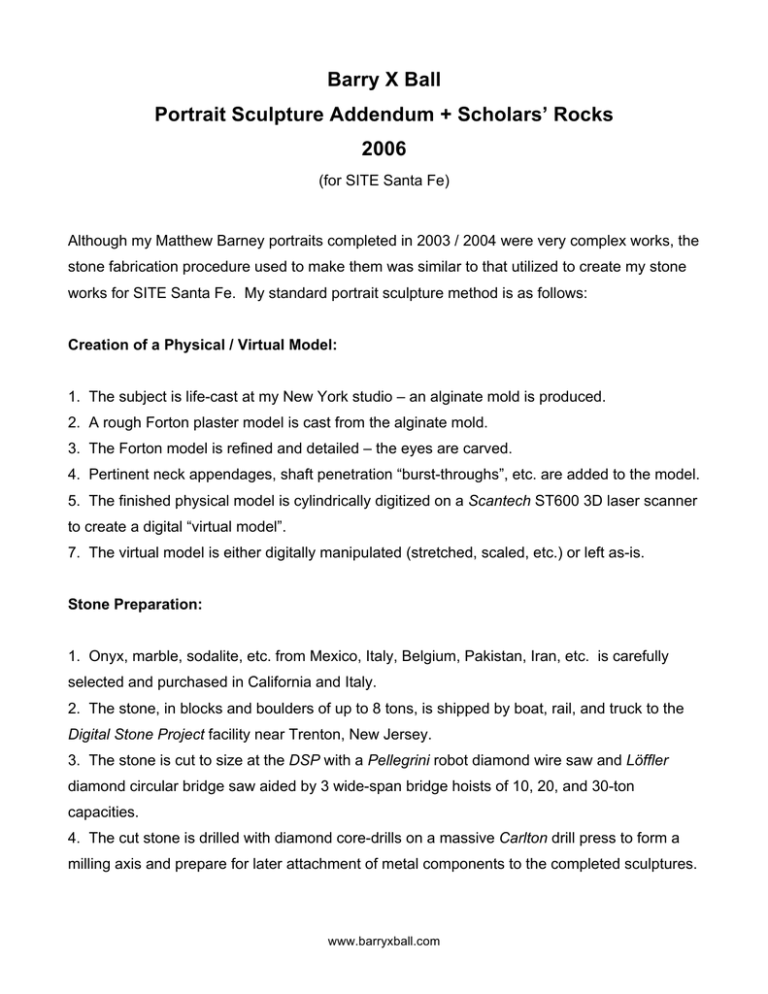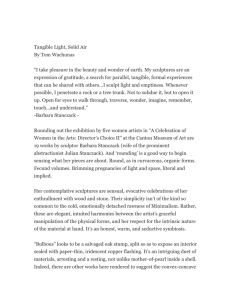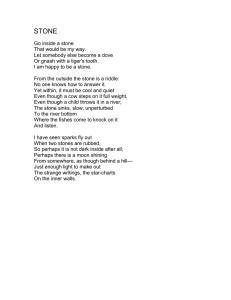BXB Portrait Sculpture Addendum + Scholars` Rocks
advertisement

Barry X Ball Portrait Sculpture Addendum + Scholars’ Rocks 2006 (for SITE Santa Fe) Although my Matthew Barney portraits completed in 2003 / 2004 were very complex works, the stone fabrication procedure used to make them was similar to that utilized to create my stone works for SITE Santa Fe. My standard portrait sculpture method is as follows: Creation of a Physical / Virtual Model: 1. The subject is life-cast at my New York studio – an alginate mold is produced. 2. A rough Forton plaster model is cast from the alginate mold. 3. The Forton model is refined and detailed – the eyes are carved. 4. Pertinent neck appendages, shaft penetration “burst-throughs”, etc. are added to the model. 5. The finished physical model is cylindrically digitized on a Scantech ST600 3D laser scanner to create a digital “virtual model”. 7. The virtual model is either digitally manipulated (stretched, scaled, etc.) or left as-is. Stone Preparation: 1. Onyx, marble, sodalite, etc. from Mexico, Italy, Belgium, Pakistan, Iran, etc. is carefully selected and purchased in California and Italy. 2. The stone, in blocks and boulders of up to 8 tons, is shipped by boat, rail, and truck to the Digital Stone Project facility near Trenton, New Jersey. 3. The stone is cut to size at the DSP with a Pellegrini robot diamond wire saw and Löffler diamond circular bridge saw aided by 3 wide-span bridge hoists of 10, 20, and 30-ton capacities. 4. The cut stone is drilled with diamond core-drills on a massive Carlton drill press to form a milling axis and prepare for later attachment of metal components to the completed sculptures. www.barryxball.com Stone Milling: 1. Digital data from the virtual model is used to program CAM (computer-assisted-milling) software that drives the three custom-built Omag CNC (computer-numerically-controlled) stone-milling machines at the DSP: a massive 5-axis gantry-style mill, a 4-axis large-scale lathe, and a 3-axis lathe for small-scale sculptures. 2. A drilled stone block is mounted on one of the CNC mills. 3. The block is CNC-milled for several days with multiple passes by progressively finer watercooled diamond tooling. The final milling passes are specified so that the surfaces of the finished sculptures have a dense web of parallel micro-flutes – longitudinal, circumferential, or diagonal – of various widths. Stone Hand-Work: 1. After CNC milling is complete, hand carving / polishing commences (and proceeds for months). The computerized machines cannot carve undercuts (e.g. backs of ears, mouth interiors, undersides of chins) and fine details such as eyes, lips, sharp edges, etc. - those areas are carved by hand with pneumatic, rotary (dental-style) grinders / diamond burrs as well as traditional stone-carving tools. Fluting is added by hand to the manually-carved passages to match the computer-controlled milling flutes. 2. Knurled stainless steel threaded inserts are permanently epoxied in the core-drilled holes so that display hardware can be later attached to the heads. 3. Sections of the sculptures (eyes, neck-recess viscera, sagging lips, impalement-stretched protrusions, etc.) are hand polished to a mirror finish. 4. The heads are finally masked, sandblasted, and oil / silicone / wax - impregnated. New Developments: To create the virtual model for my flayed / impaled / suspended, florid “Baroque” embossed Matthew Barney / BXB “scream” Janusian composite portrait, I employed several new digital technologies: www.barryxball.com 1. a state-of-the-art Boxx Technologies computer with dual AMD Opteron dual-core processors and dual NVidia 4500 graphics cards running in SLI mode 2. a Konica / Minolta Vivid 910 non-contact 3D digitizer 3. Sensable ClayTools virtual-sculpting software with 3D haptic arm Over 200 individual 3D laser scans of all the sections of an elaborate Forton plaster model were pieced together on the computer, then smoothed and detailed, and finally painstakingly digitally “embossed” with fanciful decorative elements, animal forms, religious symbols (Islamic, Jewish, and Christian), escutcheons, and dome-like rivets. This digital monstrosity was finally completed in September, after over 2 years of work. A stone sculpture will be created from this data – the 42-hour-long computer-controlled final milling pass with a tiny (1.5 mm radius) diamond cutter is underway as I type. The hand-detailing of the sculpture will commence on Thursday. I have organized my studio so that this manual work will go on almost 24 hours a day from now until mid-January. I am confident that the sculpture will be finished in time for the show. “Scholars’ Rocks” I purchased a “fake”-yet-handsome “Scholars’ Rock” for $165 (original asking price: $800) at a 2nd Avenue junk shop, then added a clay-sculpted “stretched” penumbra around it’s wooden base. The entire model was then dusted with powder so that it could be ‘read’ by the scanning laser. The digital model derived from the scan was “stretched” 3x vertically, thereby “opening up” and “monumentalizing” it. This virtual model was used to CNC-mill the two show sculptures. For #1, the upper stone is figured pink Mexican onyx, and the “base” is creamcolored translucent Mexican onyx with pronounced red venation. For #2, the upper stone is a unique piece of Mexican onyx: figured pink on one side and translucent creamy white on the other. The base for #2 is Belgian Black “marble”. The “stretched” sections of each base will be polished to a high-gloss “liquid-emergence” finish. There is an integral, deeply recessed, pronounced reveal on the stone base bottoms so that the stones will appear to “hover” above their display plinths (white base pedestals). The upper stones have been carved with differing artificial-idiosyncratic textures. www.barryxball.com



